Felling, limbing, and bucking is a common practice in the world of arborists. Whether it’s trimming the trees or simply harvesting large timber, these basic operations are involved one way or the other. So, let’s dig deeper and see how you can do felling, limbing, and bucking at the same time the right way if you’re looking to involve tree services.
Tree Felling
Felling is literally one of those things that can make or break your day. The most common misconception around felling is that it is an easy process as it only involves putting in a few cuts and the tree will fall safely on its own. Instead, felling a tree requires proper planning, and getting the tree to fall in your preferred direction is the most difficult task.
There have been incidents where trees have landed on the trucks causing significant damage. This means there are several things to keep in mind. To begin with, if the tree is smaller than 6 inches, you will be able to push it over where you want it to go.
However, if the tree is larger than 6 inches, it might probably be too heavy for you to push and control by yourself. Furthermore, before cutting a tree, perform an inspection. Trees having infections tend to be weak and there is a high chance of a heavy branch falling on you while falling.
More importantly, it might be that some areas of the tree are dead which might cause miscalculation. Keep in mind that accidents due to tree felling happen within seconds. So, in this case, you might not be able to control where the tree will fell.
For tree felling, you will need to wear safety equipment, plan the direction where the tree will fall, determine a safe route and perform the right undercut. The undercut is the most important as it will ensure the direction of the felling.
Tree Limbing
The process of cutting the limbs or branches of the tree is called limbing. The most important safety tip you need to keep in mind while limbing is to never cut limbs that are above your shoulder height, especially if you are using a chainsaw.
The reason is that you are most likely to lose balance and that can lead to serious injuries. The best way to limb a tree is by keeping the chainsaw in the front where you can see it. Other basic safety tips apply to limbing trees that are lying on the ground. You should evaluate the tree.
If you notice that it has become lodged or wedged and not properly fallen to the ground, you should not walk underneath it. Trees that are hanging to one side should not be played around with. In such situations, you will most probably need mechanical equipment to bring the tree to the ground.
Moreover, if you have just felled a tree, you might want to wait a few minutes to perform limbing as the branches and limbs may continue to fall at intervals that could be life-threatening. Once you have waited a few minutes, begin limbing from the bottom working your way up.
Additionally, never stand on the downhill side of the tree of a fallen log. If you have cut a branch that is holding the log in place, the log could roll downhill and kill you. And wherever possible, always cut the tree from the opposite side of you.
Tree Bucking
The process of cutting the tree into usable sizes is called bucking and is mostly a part of the limbing process. Bucking is usually performed when firewood is needed. This means that you should know the length you need before leaving home.
There are several different types of bucking techniques depending on the situation and angle of the tree. Regardless, it is important that you must leave a trim allowance when bucking logs and keep a firm grip on the saw with both hands.
And never stand on the downhill side of the log but uphill in case the log begins to roll during the process.
Final Word
Concluding, felling, limbing, and bucking are the three most important techniques when dealing with logs and trees. It is important that you look after your safety and utilize proper techniques to keep the risks at a minimum. Hire tree removal companies Potomac to prevent accidents.



